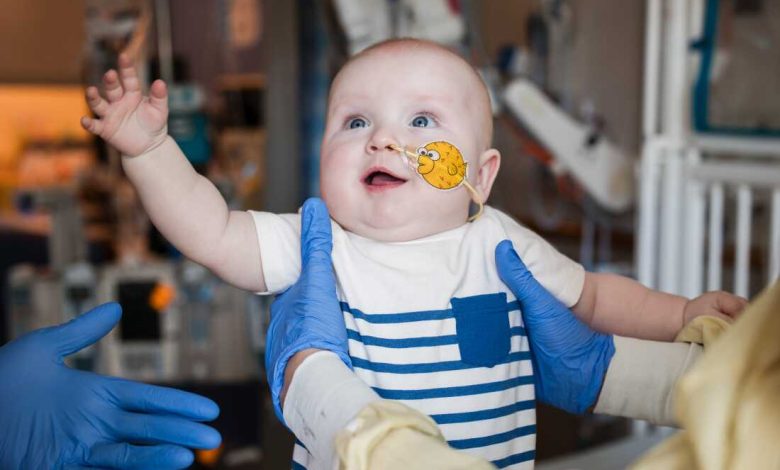Abu Dhabi Breakthrough: Newborns to Be Screened for 800+ Genetic Conditions

Introduction: A Historic Leap in Newborn Healthcare
Abu Dhabi has always been a place of innovation, luxury, and forward-thinking initiatives. But its latest healthcaremen announcement is perhaps one of the most groundbreaking yet. In a remarkable medical milestone, Abu Dhabi will begin screening newborn babies for over 800 genetic conditions, setting a new global standard for early diagnosis, prevention, and treatment.
This initiative doesn’t just reflect the UAE’s ambition in healthcare—it represents hope for millions of families who might otherwise never know their child carried a hidden genetic condition until it was too late. It’s a move that places Abu Dhabi at the forefront of medical innovation, not just regionally, but worldwide.
In this article, we’ll explore the significance of this program, what it means for families, the science behind genetic screening, and how this decision could reshape the future of medicine—not just in Abu Dhabi, but globally.
Abu Dhabi Breakthrough
The decision to launch the world’s most comprehensive newborn genetic screening program is nothing short of a breakthrough for Abu Dhabi. By committing to test babies for more than 800 genetic conditions, the Emirate is sending a clear message: healthcare is not just about treating illnesses but about preventing them before they appear. This bold initiative positions Abu Dhabi as a pioneer in global medicine, combining advanced science with compassionate care. It is a powerful step toward protecting future generations, ensuring healthier families, and setting a benchmark that other countries may soon follow.
Why Genetic Screening Matters
Genetic conditions can be silent and invisible at birth. Many disorders only manifest later in life when damage is already done. By that time, treatment is often less effective or more complicated. Genetic screening bridges this gap.
Imagine being able to:
- Detect diseases before symptoms appear.
- Plan preventive treatments or lifestyle changes early.
- Save children from unnecessary suffering.
- Give parents peace of mind and control.
This is not just about healthcare—it’s about giving newborns the healthiest possible start in life.
The Science Behind the Screening
How It Works
At birth, a small blood sample is taken—traditionally from a heel prick. With the help of cutting-edge genomic sequencing, scientists can map out the baby’s DNA. This map reveals genetic variations linked to certain diseases.
The Technology Used
Abu Dhabi’s program relies on:
- Next-Generation Sequencing (NGS): A rapid, high-throughput method of analyzing DNA.
- Bioinformatics Platforms: Software that compares DNA results against massive databases of known genetic conditions.
- AI-Assisted Diagnostics: Artificial intelligence helps detect patterns that humans may overlook.
This integration of medicine, AI, and genomics puts Abu Dhabi’s healthcare program decades ahead of the curve.
Conditions That Can Now Be Detected
Screening for 800+ conditions covers a vast spectrum of diseases, such as:
- Metabolic Disorders – Like Phenylketonuria (PKU), which can cause brain damage if untreated but is manageable with diet.
- Blood Disorders – Such as sickle cell anemia or thalassemia, both of which are more prevalent in the Middle East.
- Neurological Conditions – Like spinal muscular atrophy (SMA), where early intervention with gene therapy can be life-saving.
- Immunodeficiency Disorders – Allowing doctors to strengthen a baby’s immune system before infections cause harm.
- Rare Genetic Syndromes – Conditions so rare they are often diagnosed too late in other countries.
This wide net ensures that even the rarest and most overlooked disorders won’t go undetected.
Abu Dhabi’s Bold Move
The Emirate’s new program will use advanced genomic sequencing technologies to test for over 800 genetic conditions at birth. This includes rare metabolic, neurological, and hereditary diseases—many of which are treatable or manageable if detected early.
Globally, newborn screenings often test for around 30–60 conditions at most. Abu Dhabi’s decision to test for more than 800 conditions is revolutionary. It doesn’t just expand the medical net—it creates a safety shield around every new life entering the world.
A Global First: Setting a Healthcare Benchmark
Most countries rely on limited newborn screening panels. For example:
- United States: Screens for around 35–60 conditions depending on the state.
- UK: Screens for only 9 conditions.
- Australia: Around 25–30 conditions.
In comparison, Abu Dhabi’s 800+ condition panel represents a quantum leap forward. This could inspire other nations to adopt similar measures, changing the global healthcare landscape forever.
Benefits for Families and Society
For Families
- Early Answers: Parents don’t need to live in uncertainty.
- Better Outcomes: Treating diseases early means healthier, longer lives.
- Financial Relief: Preventing complications saves families from overwhelming medical expenses later.
For Society
- Reduced Healthcare Burden: Preventing severe diseases saves billions in long-term healthcare costs.
- Increased Productivity: Healthier children grow into healthier adults, benefiting the economy.
- Medical Leadership: Abu Dhabi becomes a hub for medical tourism and innovation.
Addressing Concerns
Privacy Issues
One major question is: What happens to a baby’s genetic data?
Abu Dhabi’s healthcare authorities assure that the program follows strict data privacy laws, ensuring information is secure and confidential.
Ethical Questions
Some parents may worry about knowing too much too soon. But healthcare experts argue that knowledge is power. With informed consent, families can make the best decisions for their child’s future.
Cost Factor
Many assume such advanced testing would be too expensive. However, by implementing it on a national scale, Abu Dhabi reduces costs significantly. Moreover, the long-term savings far outweigh initial expenses.
Voices from the Medical Community
Dr. Maryam Al Mazrouei, a leading Emirati pediatrician, shared:
“This is not just about detecting diseases—it’s about giving every child the best chance at life. We are moving from reactive medicine to proactive medicine.”
Global experts echo the sentiment, praising Abu Dhabi for its visionary leadership in healthcare.
Impact on the Future of Global Medicine
This initiative could spark a worldwide shift in how newborns are screened. Nations may follow Abu Dhabi’s lead, expanding their screening programs and investing in genetic technologies.
We might soon see a future where:
- Every newborn worldwide is screened for thousands of genetic conditions.
- Preventive medicine becomes the norm.
- Entire generations grow up healthier and stronger.
Abu Dhabi is not just leading the Middle East—it is shaping the future of global healthcare.
How Parents Can Prepare
Parents-to-be in Abu Dhabi can:
- Stay Informed: Ask their hospital about the screening process.
- Give Consent: Understand the procedures and benefits.
- Seek Counseling: Genetic counselors will guide families through results.
- Plan for Next Steps: If a condition is detected, treatment and lifestyle plans can begin immediately.
Emotional Side: What This Means for Families
For many parents, the birth of a child is both joyful and nerve-wracking. Questions like “Will my baby be healthy?” often linger. This program brings comfort and reassurance, turning uncertainty into clarity.
Imagine a mother who learns that her newborn is at risk for a serious condition—but because it’s detected early, doctors step in, and her baby grows up strong and healthy. That peace of mind is priceless.
A Vision Beyond Healthcare
Abu Dhabi’s initiative reflects more than just medical progress. It mirrors the UAE’s vision of building a knowledge-driven, future-ready society. By investing in science and medicine, the Emirate ensures that its people—and future generations—enjoy the highest quality of life.
This move also aligns with Abu Dhabi’s role as a global leader in innovation, whether in renewable energy, space exploration, or now, healthcare.
Potential Challenges Ahead
Like any pioneering program, challenges exist:
- Educating Parents: Ensuring families understand genetic results.
- Managing Rare Findings: Deciding how to handle ultra-rare conditions.
- Scaling Resources: Training enough doctors, nurses, and genetic counselors.
Yet, Abu Dhabi’s track record in overcoming obstacles suggests these challenges will be managed effectively.
Conclusion: A Healthier Tomorrow Begins Today
Abu Dhabi’s decision to screen newborns for over 800 genetic conditions is nothing short of historic. It represents a paradigm shift in medicine—from waiting for disease to appear, to preventing it before it begins.
For parents, it means hope. For children, it means healthier, longer lives. For the world, it means a new standard of healthcare.
Abu Dhabi has once again proven that innovation is not just about technology or infrastructure—it’s about people, families, and the future of humanity itself.
As we look ahead, one thing is clear: The first cry of a newborn in Abu Dhabi is now also the beginning of a healthier tomorrow.




